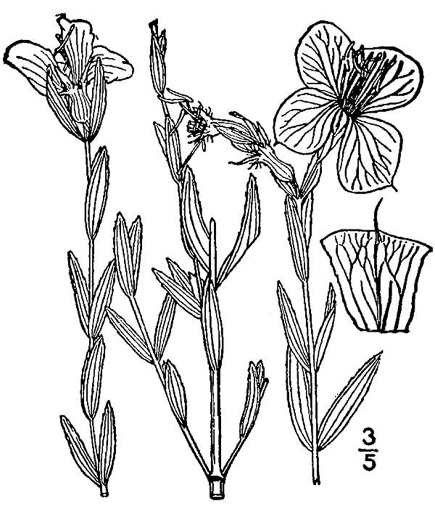Spermatophytes (seed plants): Angiosperms (flowering plants): Eudicots: Core Eudicots: Rosids: Malvids: Myrtales
WEAKLEY'S FLORA OF THE SOUTHEASTERN US (4/24/22):
Rhexia aristosa
FAMILY
Melastomataceae
Go to FSUS key
Dig deeper at SERNEC, a consortium of southeastern herbaria.
Read more about Awned Meadowbeauty at Vascular Plants of North Carolina.
SYNONYMOUS WITH
PLANTS NATIONAL DATABASE:
Rhexia aristosa
FAMILY
Melastomataceae
SYNONYMOUS WITH Flora of North America
Rhexia aristosa
SYNONYMOUS WITH VASCULAR FLORA OF THE CAROLINAS (Radford, Ahles, & Bell, 1968) 136-01-004:
Rhexia aristosa FAMILY Melastomataceae
SYNONYMOUS WITH Manual of the Southeastern Flora (Small, 1933, 1938)
Rhexia aristosa
COMMON NAME:
Awned Meadowbeauty, Bristly Meadowbeauty
To see larger pictures, click or hover over the thumbnails.
Bruce A. Sorrie bas_rhexia_aristosa1
September Hoke County NC
The long yellowish bristles at the summit of the calyx/hypanthium are diagnostic, per Weakley's Flora (2022).
WEAKLEY'S FLORA OF THE SOUTHEASTERN US (4/24/22):
Rhexia aristosa
FAMILY
Melastomataceae
SYNONYMOUS WITH
PLANTS NATIONAL DATABASE:
Rhexia aristosa
FAMILY
Melastomataceae
SYNONYMOUS WITH
Flora of North America
Rhexia aristosa
SYNONYMOUS WITH
VASCULAR FLORA OF THE CAROLINAS (Radford, Ahles, & Bell, 1968) 136-01-004:
Rhexia aristosa
FAMILY
Melastomataceae
SYNONYMOUS WITH
Manual of the Southeastern Flora (Small, 1933, 1938)
Rhexia aristosa
If a search such as "Carex leptalea var. leptalea" doesn't deliver the results you want, try "Carex leptalea".
Or, to minimize chances of a misspelling, try just "Carex le".
Less is more: If "pencil flower" doesn't deliver the results you want, try "pencil".



